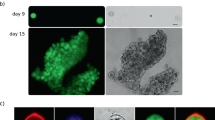Summary
We determined the time and site of secretion of the precursors of the peritrophic membrane (PM) in Aedes aegypti and when the structure is assembled. The fine structure of the developing membrane of blood-feed females was described, and the pattern of secretion of injected tritiated glucosamine analyzed autoradiographically. Immediately following blood feeding, ingested red cells rapidly become compressed, such that the surrounding plasma is extruded to the margin of the midgut contents. Thereby, ingested fluids form a narrow margin separating the blood mass from the midgut epithelium. By electron microscopy, the PM first becomes evident at about 4 to 8 h after blood is ingested, and the membrane attains mature texture by 12 h. The compacted mass of ingested erythrocytes seems to serve as a template for the forming structure. In contrast, tritiated glucosamine, injected into freshly engorged mosquitoes, begins to concentrate on the midgut microvilli by 2 h after feeding. By 8 h the label assumes the layered appearance that characterizes the fine structure of the mature membrane. In contrast to the prevailing concept that the PM of mosquitoes first assumes texture anteriorly immediately after blood is ingested, we find that this potential barrier to pathogen development forms no earlier than 4 h after feeding and that it is formed from precursors secreted along the entire length of the epithelium overlying the food mass.
Similar content being viewed by others
References
Berner R, Rudin W, Hecker H (1983) Peritrophic membranes and protease activity in the midgut of the malaria mosquito, Anopheles stephensi (Liston) (Insecta: Diptera) under normal and experimental conditions. J Ultrastruct Res 83:195–204
Bertram DS, Bird RG (1961) Studies on mosquito-borne viruses in their vectors, 1. The normal fine structure of the midgut epithelium of the adult female Aedes aegypti (L.) and the functional significance of its modifications following a blood meal. Trans R Soc Trop Med Hyg 55:404–423
Day MF, Waterhouse DF (1953) Structure of the alimentary system. Function of the alimentary system. The mechanism of digestion. In: Roder KD (ed) Insect Physiology. John Wiley, New York, pp 273–330
DeMets R, Jeuniaux C (1962) Sur les substances organiques constituant la membrane péritrophique des insectes. Arch Int Physiol Biochim 70:93–96
Freyvogel T, Jaquet C (1965) The prerequisites for the formation of a peritrophic membrane in Culicidae females. Acta Trop 22:148–154
Freyvogel T, Staubli W (1965) The formation of the peritrophic membrane in Culicidae. Acta Trop 22:118–147
Gander E (1968) Zur Histologie und Histochemie des Mitteldarmes von Aedes aegypti und Anopheles stephensi im Zusammenhang mit der Blutverdauung. Acta Trop 25:133–175
Hecker H (1977) Structure and function of midgut epithelial cells in Culicidae mosquitoes (Insecta, Diptera). Cell Tissue Res 184:321–341
Howard LM (1962) Studies of the mechanism of infection of the mosquito midgut by Plasmodium gallinaceum. Am J Hyg 75:287–300
Houk EJ (1977) Midgut ultrastructure of Culex tarsalis (Diptera: Culicidae) before and after a bloodmeal. Tissue Cell 9:103–118
Houk EJ, Hardy JL (1982) Midgut cellular responses to bloodmeal digestion in the mosquito, Culex tarsalis Coquillet (Diptera: Culicidae). Int J Insect Morphol Embryol 11:109–119
Houk EJ, Obie F, Hardy JL (1979) Peritrophic membrane formation and the midgut barrier to arboviral infection in the mosquito Culex tarsalis Coquillett (Insecta, Diptera). Acta Trop 36:39–45
Kaznowski CE, Scheiderman HA, Bryant PJ (1986) The incorporation of precursors into Drosophila larval cuticle. J Insect Physiol 32:133–142
Locke M (1964) The structure and formation of the integument in insects. Physiol Insecta 3:380–466
Neville AC (1967) Chitin orientation in cuticle and its control. Adv Insect Physiol 4:213–286
Orihel TC (1975) The peritrophic membrane: its role as a barrier to infection of the arthropod host. In: Maramorosch K, Shope RE (eds) Invertebrate Immunity Academic Press, New York, p 65–73
Pearse AGE (1961) Histochemistry Theoretical and Applied. 2nd ed Little, Brown and Co., Boston
Perrone JB, DeMaio J, Spielman A (1986) Regions of mosquito salivary glands distinguished by surface lectin-binding characteristics. Insect Biochem 16:313–318
Richards GA, Richards PA (1977) The peritrophic membrane of insects. Ann Rev Entomol 22:219–240
Richardson M, Romoser WS (1972) The formation of the peritrophic membrane in adult Aedes triseriatus (Say) (Diptera: Culicdae). J Med Entomol 9:494–500
Romoser WS, Cody E (1975) The formation and fate of the peritrophic membrane in adult Culex nigripalpus (Diptera: Culicidae). J Med Entomol 12:371–378
Stohler H (1957) Analyse des Infektionsverlaufes von Plasmodium gallinaceum im Darme von Aedes aegypti. Acta Trop 14:303–352
Sutherland DR, Christensen BM, Lasee BA (1986) Midgut barrier as a possible factor in filarial worm vector competency in Aedes trivittatus. J Invert Pathol 47:1–7
Tormey JM (1964) Differences in membrane configuration between osmium tetroxide-fixed and glutaraldehyde-fixed ciliary epithelium. J Cell Biol 23:658–664
Waterhouse DF (1953) The occurrence and significance of the peritrophic membrane, with special reference to adult Lepidoptera and Diptera. Aust J Zool 1:299–318
Wigglesworth VB (1965) The Principles of Insect Physiology. 6th ed Methuen and Co. Ltd., London
Williams JC, Hagedorn HH, Beyenbach KW (1983) Dynamic changes in flow rate and compostion of urine during the postbloodmeal diuresis in Aedes aegypti (L.). J Comp Physiol 153:257–265
Zhuzhikov DP (1962) The formation of the peritrophic membranes in Aedes aegypti L. mosquitoes. Nauchn Dokl Vyssh Shk Biol 4:25–27
Author information
Authors and Affiliations
Rights and permissions
About this article
Cite this article
Perrone, J.B., Spielman, A. Time and site of assembly of the peritrophic membrane of the mosquito Aedes aegypti . Cell Tissue Res. 252, 473–478 (1988). https://doi.org/10.1007/BF00214391
Accepted:
Issue Date:
DOI: https://doi.org/10.1007/BF00214391




